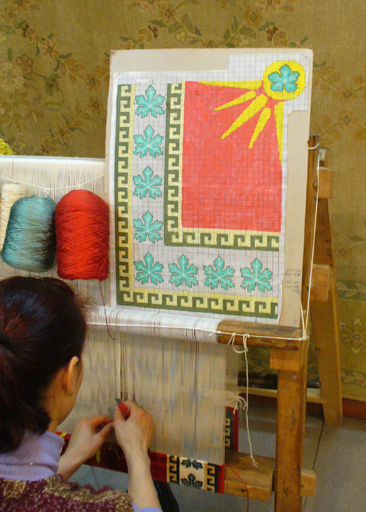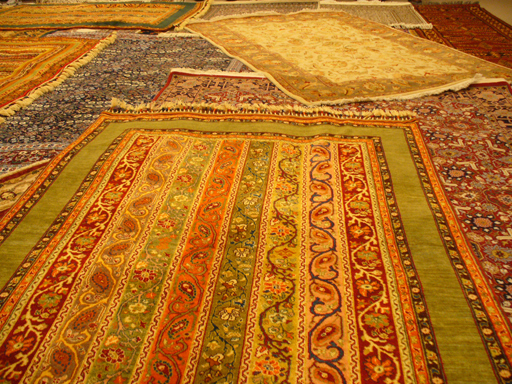 In an area where women were working, we saw this woman tying the knots which make up the carpet. The pattern she is following is pictured on the loom.
In an area where women were working, we saw this woman tying the knots which make up the carpet. The pattern she is following is pictured on the loom.
 After the knots in a few rows have been tied she uses special adjustable scissors to trim the pile evenly after the knots have been pressed down. These scissors can be adjusted according to the desired pile length.
After the knots in a few rows have been tied she uses special adjustable scissors to trim the pile evenly after the knots have been pressed down. These scissors can be adjusted according to the desired pile length.

Especially interesting was the preparation of silk for the silk carpets. Here the silkworm cocoons are placed in heated water. The brush in the foreground is then used to begin unravelling the silk from the cocoon. The woman then uses circular hand motions to unwind the outer layers of silk, since they will be used for other purposes than silk carpets.
 Only about 1/3 of the silk is good enough for silk carpets, and once the outer fibers have been removed, the silk from a number of cocoons is wound together and then pulled onto a large reel.
Only about 1/3 of the silk is good enough for silk carpets, and once the outer fibers have been removed, the silk from a number of cocoons is wound together and then pulled onto a large reel.
 Winding together a number of strands produces a very strong silk string.
Winding together a number of strands produces a very strong silk string.
 We were then shown the area where they had a number of carpets for us to see (and buy?)
We were then shown the area where they had a number of carpets for us to see (and buy?)
 We were shown kilim, which are tapestry-woven carpets
We were shown kilim, which are tapestry-woven carpets
 Then we saw the more expensive carpets, wool and silk on wool.
Then we saw the more expensive carpets, wool and silk on wool.
 We were even invited to walk on them.
We were even invited to walk on them.
Next we go to the Temple of Artemis.
